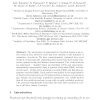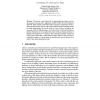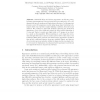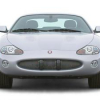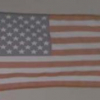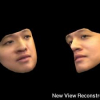MICCAI
2008
Springer
16 years 1 months ago
2008
Springer
Abstract. The automation of segmentation of medical images is an active research area. However, there has been criticism of the standard of evaluation of methods. We have comprehen...
82
Voted
ICIP
2002
IEEE
16 years 2 months ago
2002
IEEE
In this article we present a new method for automatic landmark extraction from the contours of biological specimens. Our ultimate goal is to enable automatic identification of bio...
72
Voted
ECCV
1998
Springer
16 years 2 months ago
1998
Springer
113
click to vote
ECCV
2004
Springer
16 years 2 months ago
2004
Springer
Abstract. Statistical shape and texture appearance models are powerful image representations, but previously had been restricted to 2D or 3D shapes with smooth surfaces and lambert...
92
Voted
ICCV
2005
IEEE
16 years 2 months ago
2005
IEEE
Active appearance models (AAMs) provide a framework for modeling the joint shape and texture of an image. An AAM is a compact representation of both factors in a conditionally lin...
118
click to vote
CVPR
2008
IEEE
16 years 2 months ago
2008
IEEE
Parameterized Appearance Models (PAMs) (e.g. eigentracking, active appearance models, morphable models) use Principal Component Analysis (PCA) to model the shape and appearance of...
114
Voted
CVPR
2007
IEEE
16 years 2 months ago
2007
IEEE
We are interested in modeling the variability of different images of the same scene, or class of objects, obtained by changing the imaging conditions, for instance the viewpoint o...
104
Voted
CVPR
2005
IEEE
16 years 2 months ago
2005
IEEE
In this work we propose a model for video scenes that contain temporal variability in shape and appearance. We propose a conditionally linear model akin to a dynamic extension of ...
106
click to vote
CVPR
2004
IEEE
16 years 2 months ago
2004
IEEE
Active Appearance Models (AAMs) are generative models commonly used to model faces. Another closely related type of face models are 3D Morphable Models (3DMMs). Although AAMs are ...
106
click to vote
ICCV
2009
IEEE
16 years 5 months ago
2009
IEEE
2D Active Appearance Models (AAM) and 3D Morphable
Models (3DMM) are widely used techniques. AAM
provide a fast fitting process, but may represent unwanted
3D transformations un...
